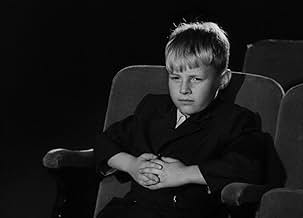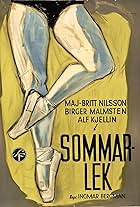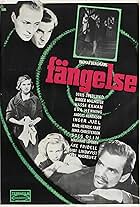IMDb RATING
7.2/10
3.5K
YOUR RATING
Two violinists playing in the same orchestra fall in love and get married, but they can't get along.Two violinists playing in the same orchestra fall in love and get married, but they can't get along.Two violinists playing in the same orchestra fall in love and get married, but they can't get along.
Staffan Axelsson
- Lasse - Age 3
- (uncredited)
Astrid Bodin
- Guest at Marta's Birthday Party
- (uncredited)
Tor Borong
- Expecting Father at the Maternity ward
- (uncredited)
Ernst Brunman
- Concert Hall Doorkeeper
- (uncredited)
Eva Fritz-Nilsson
- Lisa - Age 3
- (uncredited)
Agda Helin
- Nurse
- (uncredited)
Svea Holm
- Mother at the Maternity Ward
- (uncredited)
Berit Holmström
- Lisa
- (uncredited)
Svea Holst
- Nurse
- (uncredited)
Maud Hyttenberg
- Toy Shop Assistant
- (uncredited)
- Director
- Writer
- All cast & crew
- Production, box office & more at IMDbPro
Storyline
Did you know
- TriviaOne of four Ingmar Bergman films never released theatrically in the US, although it did appear in America on videotape in 1984, and on Blu-ray in 2018
- ConnectionsFeatured in Victor Seastrom (1981)
- SoundtracksSYMPHONY NO 9, OP. 125 ('AN DIE FREUDE')
Music by Ludwig van Beethoven
Featured review
Stig and Marta are two young musicians playing together in a Swedish orchestra. They meet, they fall in love and they get married. If this synopsis leaves you expecting a romantic film, you'll be disappointed to find out a rough, realistic, yet very sentimental piece of art.
In this film, Bergman uses a quite interesting storytelling method that works really effectively. Although the way their marriage ends is revealed to us in the opening sequence making the rest of the film a flashback (a technique with which Bergman is already familiar with), when the movie reaches its final scene, one can't help but be extremely moved by the way things end up.
Once again, the performances are great and it is clear that these actors open up their own private world for all of us to see, and they can do that simply because they feel comfortable with a director like Bergman. They know they are in safe hands. Victor Sjostrom definitely steals the show (and Bergman will work with him again in Wild Strawberries), but it is the face of Maj-Britt Nilsson (Marta) that will remain in your mind for a long time.
Already in these early films of his, the Swedish master shows his love for close-ups. He likes to diminish the distance between the audience and the actors, especially their faces, sharing the belief that not only their eyes, but also the texture of their skin can reveal to us a whole lot of things about the characters. After all, close ups are one of the great advantages of cinema that have ultimately become one of the most characteristic building blocks of this art form, and Bergman working simultaneously in the theatre, is very much aware of that. Although the extreme close ups are easier to notice and admire, Bergman has also a great arsenal of shots and camera movements that so easily uses in this film. The shots of the orchestra performing either from high above or through the musicians, shows a camera that can move constantly but also in a discreet and, one could say, abstract way. He also proves to be very capable with mise-en-scene, as deep-focus long takes are used in several scenes.
The use of music is also notable, as you will definitely see for yourselves in the remarkable montage sequence in the ending. Classical music is of course common in the director's filmography, but it follows certain stages that are worth mentioning. In his first period, in which "To Joy" is definitely included, Bergman uses pieces performed by large orchestras, grandiose in a way. And it's certainly no coincidence that in these films, a great number of characters are used for narrative purposes (surely Stig are Marta are in the foreground, but there's also the conductor, Sonderby, the mistress and her old husband, Marcel and a few others). But from early 60's on, begins a period in which Bergman uses music of a smaller scale (especially string quartets) and in these films very few characters are introduced to us and, very often, in an isolated place (e.g. Through a Glass Darkly, Silence, Persona).
If you watch carefully this film, you will see many signs of what Ingmar Bergman is going to evolve to. His dramatic approach in human relationships and his effort to capture those moments between two heartbeats, between two lovers. But also his realistic point of view, especially when it comes to marriage (as Scenes From a Marriage a good 20 years after will confirm). A very good film.
In this film, Bergman uses a quite interesting storytelling method that works really effectively. Although the way their marriage ends is revealed to us in the opening sequence making the rest of the film a flashback (a technique with which Bergman is already familiar with), when the movie reaches its final scene, one can't help but be extremely moved by the way things end up.
Once again, the performances are great and it is clear that these actors open up their own private world for all of us to see, and they can do that simply because they feel comfortable with a director like Bergman. They know they are in safe hands. Victor Sjostrom definitely steals the show (and Bergman will work with him again in Wild Strawberries), but it is the face of Maj-Britt Nilsson (Marta) that will remain in your mind for a long time.
Already in these early films of his, the Swedish master shows his love for close-ups. He likes to diminish the distance between the audience and the actors, especially their faces, sharing the belief that not only their eyes, but also the texture of their skin can reveal to us a whole lot of things about the characters. After all, close ups are one of the great advantages of cinema that have ultimately become one of the most characteristic building blocks of this art form, and Bergman working simultaneously in the theatre, is very much aware of that. Although the extreme close ups are easier to notice and admire, Bergman has also a great arsenal of shots and camera movements that so easily uses in this film. The shots of the orchestra performing either from high above or through the musicians, shows a camera that can move constantly but also in a discreet and, one could say, abstract way. He also proves to be very capable with mise-en-scene, as deep-focus long takes are used in several scenes.
The use of music is also notable, as you will definitely see for yourselves in the remarkable montage sequence in the ending. Classical music is of course common in the director's filmography, but it follows certain stages that are worth mentioning. In his first period, in which "To Joy" is definitely included, Bergman uses pieces performed by large orchestras, grandiose in a way. And it's certainly no coincidence that in these films, a great number of characters are used for narrative purposes (surely Stig are Marta are in the foreground, but there's also the conductor, Sonderby, the mistress and her old husband, Marcel and a few others). But from early 60's on, begins a period in which Bergman uses music of a smaller scale (especially string quartets) and in these films very few characters are introduced to us and, very often, in an isolated place (e.g. Through a Glass Darkly, Silence, Persona).
If you watch carefully this film, you will see many signs of what Ingmar Bergman is going to evolve to. His dramatic approach in human relationships and his effort to capture those moments between two heartbeats, between two lovers. But also his realistic point of view, especially when it comes to marriage (as Scenes From a Marriage a good 20 years after will confirm). A very good film.
- theachilles
- Jan 19, 2007
- Permalink
- How long is To Joy?Powered by Alexa
Details
Box office
- Gross worldwide
- $5,135
- Runtime1 hour 38 minutes
- Color
- Sound mix
- Aspect ratio
- 1.37 : 1
Contribute to this page
Suggest an edit or add missing content































